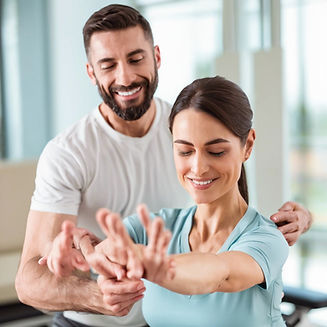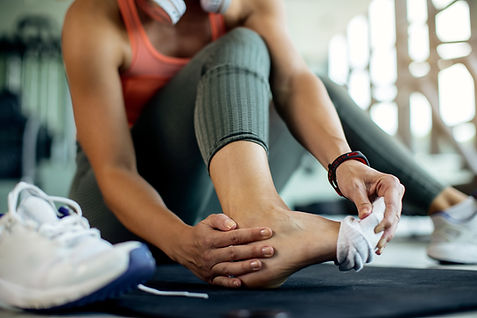
PREVALENT INJURIES & EMPHASIS


General Category of Common Conditions
-
Pre/Post-surgical rehabilitation
-
Swelling/Edema/ Irregular circulation
-
Musculoskeletal dysfunction
-
Sciatica
-
Back pain/Herniated disc
-
Rotator cuff injuries
-
Neck & shoulder dysfunction
-
Meniscal & ACL knee injuries
-
Carpal Tunnel Syndrome
-
Osteoarthritis
-
Cervical and Lumbar Radiculoipathy
-
Cervical and Lumbar Stenosis
-
Spondylosis/ Spondylolysis/ Spondylitis/ Spondylolisthesis
-
Senior Fitness & Balance Dysfunction
-
Cardiopulmonary Deficit
-
Pre/post pregnancy back pain
-
Headaches
-
RSD –Reflex Sympathetic Dystrophy (CRPS-Complex Regional Pain Syndrome)
-
Fibromyalgia/Chronic pain syndrome
-
Hand trauma
-
Ankle & foot injuries
-
Neurological disorders
-
Sacroiliac dysfunction
-
Hip dysfunction
-
Epicondylitis (tennis elbow)
-
Stroke rehabilitation
-
Repetitive Strain
-
Cumulative Trauma Disorder
-
Nerve Entrapments
-
Plantar Fasciitis
-
Shoulder Tendonitis
Specific Conditions by Body Areas:
Neck
-
Muscle Spasm
-
Degenerative Disc Disease
-
Cervical Sprain/Strain
-
Cervical Disc Herniation
-
Cervical Stenosis
-
Nerve Impingement (Cervical Radiculopathy)
-
Arthritis/ Arthrosis

Shoulder
-
Shoulder Sprain/Strain
-
Frozen Shoulder (Adhesive Capsulitis)
-
Shoulder Tendonitis/Bursitis
-
Shoulder Instability
-
Arthritis/ Arthrosis
-
Biceps Tendonitis
-
Shoulder Impingement
-
Rotator Cuff Tear

Elbow
-
Tennis Elbow (Lateral Epicondylitis)
-
Golfer’s Elbow (Medial Epicondylitis)
-
Ulnar Neuropathy
-
Elbow Sprain/Strain
-
Olecranon Bursitis
-
Forearm pain/pathology
-
Arthritis/ Arthrosis

Hand & Wrist
-
De Quervain’s Tenosynovitis
-
Tendonitis
-
Arthritis/ Arthrosis
-
Trigger Finger
-
Wrist/Hand Sprain/Strain Ganglion Cyst
-
Carpal Tunnel Syndrome

Hip
-
Hip subluxation
-
Total/Partial Hip Surgery
-
Trochanteric Bursitis
-
Arthritis/ Arthrosis
-
Hip Sprain/Strain
-
General Hip Pain/ Dysfunction
-
Sciatica (originating from hip)
-
General Hip pain /dysfunction

Ankle & Foot
-
Ankle Sprain/Strain
-
Tendonitis
-
Shin Splints
-
Ankle Instability
-
Achilles Tendonitis
-
Arthritis/ Arthrosis
-
Tarsal Tunnel Syndrome
-
Plantar Fasciitis
-
Halux Valgus
-
Hammer Toe/ Bunions

Physical & Sports Activity
-
Meniscus Tears
-
ACL/PCL Tear
-
Neck Pain
-
Tennis Elbow (Lateral Epicondylitis)
-
Golfer’s Elbow (Medial Epicondylitis)
-
Shoulder Pain / Shoulder Instability
-
MCL / LCL Sprain / Tear
-
Achilles Tendonitis
-
Shin Splints Rotator Cuff Injury
-
Stress Fracture
-
Ligament Sprain/Muscle Strain

Back
-
Nerve Impingement (Lumbar Radiculopathy)
-
Muscle Spasm
-
Degenerative Disc Disease
-
Lumbar Stenosis
-
Herniated Disc
-
Back Pain
-
Thoracic or Lumbar Sprain/Strain
-
Arthritis/ Arthrosis
-
Spondylosis/ Spondylolysis/ Spondylitis/Spondylolisthesis
-
Sacroiliac Joint Dysfunction
-
Piriformis Syndrome
-
Sciatica
-
Scoliosis
-
General Stiffness

Knee
-
Meniscus Tears
-
ACL/PCL Tear
-
MCL / LCL Sprain / Tear
-
Knee Bursitis
-
Meniscal injury/pathology
-
Tendonitis
-
Patellofemoral Pain Syndrome
-
Iliotibial Band Syndrome
-
Chondromalacia Patella
-
Arthritis/ Arthrosis
-
Patellar Tendonitis


